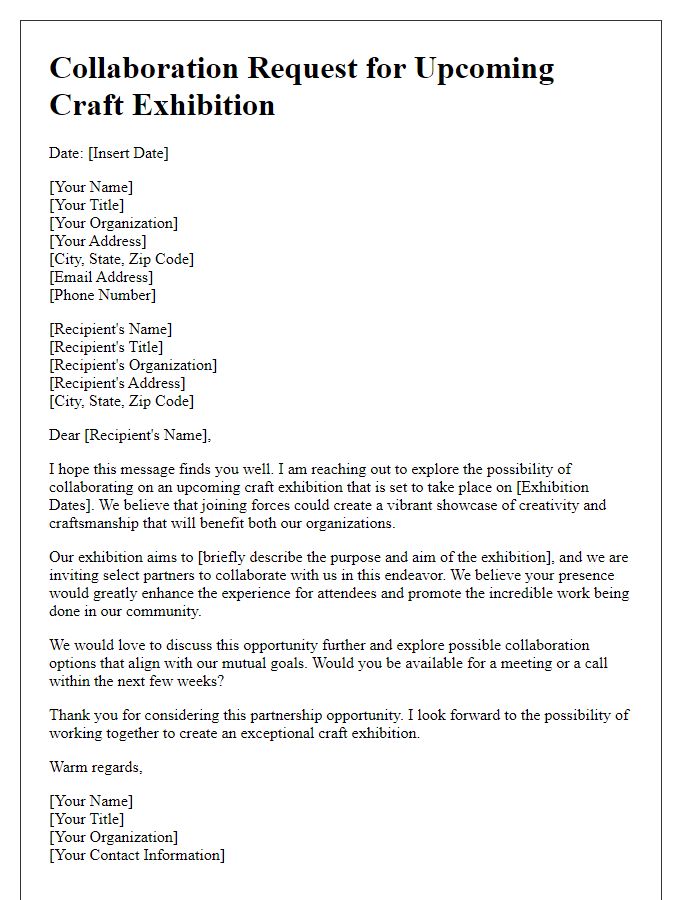Are you an aspiring artist or a passionate crafter looking to showcase your talent? Craft exhibitions provide the perfect platform to connect with fellow creatives and display your unique creations to the world. In this article, we will explore essential tips and guidelines for crafting a compelling proposal that stands out from the crowd. So, grab a cup of coffee and get ready to learn how to elevate your exhibition gameâread on for more!

Event objective and theme relevance
The Craft Proposal Exhibition aims to celebrate the intricate artistry and cultural significance of handmade crafts. This event will showcase local artisans and their unique creations, emphasizing the importance of traditional techniques and contemporary interpretations. The theme "Roots and Innovation" highlights the blend of heritage and modernity, inviting attendees to explore how traditional crafts evolve while retaining their historical essence. With over 50 participating artists from diverse backgrounds, the exhibition will feature a range of visual art forms, including pottery, textiles, and woodworking. Educational workshops during the event will provide insights into various crafting techniques, promoting engagement and appreciation for the skill involved in handmade creations. This exhibition seeks to foster community connections and support local talent, creating a vibrant platform for artistic expression and cultural dialogue.
Target audience and demographic alignment
Craft proposals tailored for exhibitions require a deep understanding of target audience demographics, which encompass essential factors such as age groups, cultural backgrounds, and socioeconomic status. For example, an audience primarily comprising millennials aged 25-40 may demonstrate a preference for sustainable crafts that utilize eco-friendly materials and innovative designs, reflecting their values regarding environmental conservation. Conversely, a demographic of families with children might gravitate towards interactive exhibits, crafts that promote creativity, and educational workshops focusing on hands-on experiences. Aligning craft proposals with these demographics ensures that the exhibition resonates with attendees, fostering engagement and maximizing participation in activities. Additionally, understanding the local community's cultural landscape, such as prevalent artistic styles and traditions in cities like Santa Fe or Asheville, can further enhance alignment and relevance, making the exhibition not only a showcase of craftsmanship but also a celebration of shared cultural identity.
Unique selling proposition and originality
Craft exhibitions provide a platform for artisans and creators to showcase their unique craftsmanship and innovative designs. Originality in handmade items, such as intricate jewelry or bespoke furniture, captures the attention of attendees, making it essential to highlight unique selling propositions (USPs) in proposals. A proposal should emphasize distinctive materials used, like reclaimed wood or ethically sourced gemstones, and innovative techniques employed in the crafting process. Additionally, emphasizing the story behind each piece, such as cultural significance or personal inspiration, can further engage audiences and validate the originality of the creations. Engaging visuals, detailed descriptions, and artist profiles can bolster the overall appeal, ensuring that the exhibition stands out in a crowded marketplace rich with creativity and artisan talent.
Marketing and promotional strategy
The marketing and promotional strategy for the craft proposal exhibition encompasses various channels to maximize visibility and engagement. Social media platforms such as Instagram, Facebook, and Pinterest will be utilized to showcase artisans and their handcrafted goods, leveraging visually appealing content to attract potential attendees. Local partnerships with community organizations and craft stores, particularly in areas known for their vibrant arts scenes, will enhance word-of-mouth promotion. Press releases targeting local newspapers like the Boston Globe and magazines such as Craft Industry Today will inform the public and generate buzz. Additionally, an email marketing campaign will reach out to previous attendees, offering exclusive sneak peeks and early-bird ticket discounts to encourage participation. Targeted advertisements on platforms like Google Ads will ensure the exhibition reaches craft enthusiasts and collectors in the vicinity of the venue, such as the historic arts district in Santa Fe, New Mexico. Engaging influencers in the crafting community to share their experiences and highlights from the exhibition will further increase outreach and attract diverse demographics.
Budget overview and funding sources
The budget overview for the craft proposal exhibition outlines the financial requirements necessary to successfully execute the event. Total estimated costs amount to $25,000, which includes venue rental at the Downtown Arts Center, valued at $5,000, staffing costs totaling $8,000 for event coordinators and volunteers, materials and supplies budgeted at $4,000 for craft creation and display, marketing expenses projected at $3,000 for promotional materials and online advertisements, and a contingency fund of $5,000 to cover unexpected expenses. Potential funding sources include local arts grants such as the Community Arts Grant, with available funding of up to $10,000, sponsorship from local businesses like Craft Haven Boutique offering $3,000, crowdfunding campaigns through platforms like GoFundMe anticipated to generate $5,000, and participation fees from artists to raise an additional $2,000. This diversified funding strategy aims to ensure financial stability for the exhibition while promoting community engagement and collaboration.













Comments